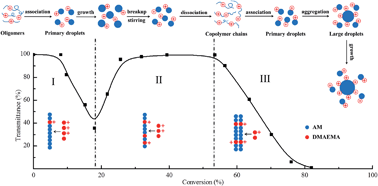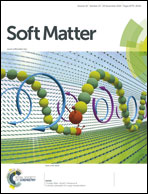Unique multiple soluble–insoluble phase transitions in aqueous two-phase copolymerization of acrylamide and a weakly charged comonomer
Abstract
A unique phenomenon of multiple soluble–insoluble phase transitions was found in the two-phase copolymerization of acrylamide (AM) and a weakly charged comonomer, N,N-dimethylaminoethyl methacrylate (DMAEMA), in the aqueous solution of poly(ethylene glycol) (PEG). As the DMAEMA molar fraction increased from 0 to 0.30, the insoluble–soluble (I–S) phase transition first appeared and then disappeared. Varying the PEG concentration, the salt concentration, or the pH of reaction mixture, the phase transitions were tuned dependently. The volume fractions and refractive indices of continuous and disperse phases, as well as the viscosity change in the phase transitions were investigated, and the results showed that phase reentrance had occurred in the I–S phase transition. The transitional conversion for the first S–I phase transition increased with the DMAEMA molar fraction, indicating the solubility enhancement of charged polyelectrolytes. The content of DMAEMA in the resulting copolymer first increased and then decreased as the polymerization progressed. Accordingly, the droplet size increased in the two S–I phase transitions and decreased in the I–S phase transition. And it was proved that the copolymers were molecularly solubilized after the I–S phase transition. The multiple soluble–insoluble phase transitions were ascribed to the synergistic effect of polymer concentration, solubility enhancement of charged copolymers, and the salting-out effect of ionic comonomers. A generalized mechanism for the multiple soluble–insoluble phase transitions was proposed, which showed that the effects of polymer concentration were dominant in the two S–I phase transitions, while the effects of solubility enhancement played a key role in the I–S phase transition.


 Please wait while we load your content...
Please wait while we load your content...